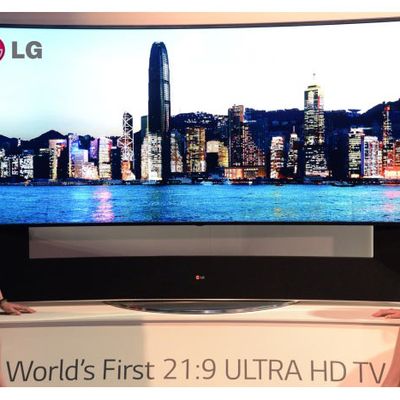
Because life is too short, I’m not attending this year’s Consumer Electronics Show, the annual Vegas trade show for new tech gizmos of all stripes. But from early reports, it appears that this year’s CES is shaping up to be a lot like all the others – an orgy of improbable gadget prototypes, and mountains of drooling praise centered on one or two categories (this year, the Internet of Things and wearable computing appear to be the belles of the ball). And, as in most recent years, this year’s biggest CES hype magnet is going to be the TV – specifically, a pair of 105-inch, ultra-high-definition, curved-screen TVs released by LG and Samsung.
TVs are to CES as Ford cars were to the mid-century World’s Fair – it’s hard to imagine the exhibition without them. But as the New York Times points out today, TV-makers are getting a little worried that nobody will buy their flashy new models, since nearly everyone has a perfectly functional TV already, and those who don’t can get one cheaply. “The TV industry has innovated itself into a corner,” the paper writes.
You’ll see a lot of breathless reports from this year’s CES about all the new ways TV-makers are trying to recapture the market’s attention. LG is bringing back webOS, a failed product that promised to merge the TV and the computer back in 2009. Samsung is introducing a new TV remote that has a small trackpad on it. And both companies are talking up their new curved-screen displays, which apparently reduce glare and make it easier to see the screen from side angles. None of these are tremendously groundbreaking innovations, but then again, groundbreaking innovations may not be possible for TVs these days.
The TV, like the computer mouse or the inkjet printer, has run up against a kind of creative asymptote. There was once a period when it made sense to upgrade your TV every few years, because the technology was improving by leaps and bounds. New models had HD, or USB ports, or just obviously better screen quality. But now, they’ve become something close to a commodity. You can get a 50-inch, high-def LED flat screen from a major manufacturer for well under $1,000. (Here’s one for $648.) That’s more than enough for most people. And unless you’re a real screen geek, you probably won’t notice all that much difference in a new model that costs six or eight times as much.
Incremental modifications may “trick rich people,” as Farhad Manjoo puts it, into buying new TVs for a while. But TV-makers know they can’t just sell new units to a handful of spec-obsessed die hards. In order to be profitable in the long run, they need lots of normal people to upgrade their sets every year. And so they’re hoping that jamming ultra-high-definition screens and features like webOS into new sets will convince people that their old models are insufficient. This year’s hope is that Internet-connected TVs will restore some momentum to a shrinking sector:
Over all, in the year that ended in November, TV makers sold $15.5 billion worth of sets in the United States in 2013, down about 4 percent from the same period in 2012, according to NPD. Worldwide, manufacturers shipped 155.4 million television sets in the first three quarters of 2013, down about 3.6 percent from the same period in 2012, according to NPD DisplaySearch.
The big problem facing these manufacturers, of course, is that most people don’t care whether their TVs have 4K resolution or not. They want a TV that will look good at most angles, that mounts easily on a wall or has a functional stand attached, and that will last them more than a few years. The new features that do excite consumers — YouTube compatibility, the ability to stream Netflix movies and Pandora stations, and the ability move videos seamlessly between a tablet or laptop and a TV — already exist in relatively cheap add-ons that can be purchased separately and attached to your existing TV, rather than upgrading.
I’m a fairly good case study for the TV industry’s problems. I bought a new TV three years ago, when I moved to a new apartment and wanted a slightly bigger screen to fill out an empty wall. And since then, I’ve added some features – an Xbox for games and DVDs, a Roku for streaming Netflix and Amazon videos, a universal remote. But I haven’t even considered buying a new TV altogether.
In fact, unless my current one breaks, I can’t think of a reason I would ever buy a new TV. My current model (a 42-inch Samsung) isn’t top-of-the-line, but it works fine. I watch most short videos on my laptop or iPad, I don’t have cable, and I don’t watch enough Netflix movies on my TV to care whether I could be getting a slightly better color balance, or slightly less glare, on an expensive new model. Unless the TV industry can find a way to force obsolescence on its old products — like making new models of devices like the Roku incompatible with TVs made before 2011 — the appeal of new models will be limited to TV addicts and people with too much disposable income.
So if you’re at this year’s CES, don’t be fooled by the smiles of excited TV executives introducing flashy new models with curved screens and cornea-busting resolutions. Under the surface, they’re panicking — and they should be.





























